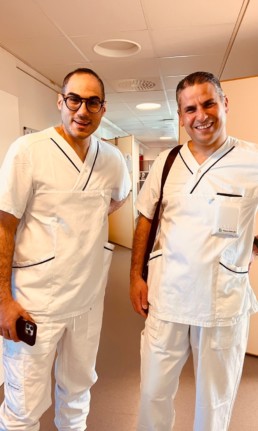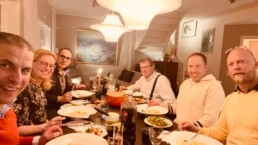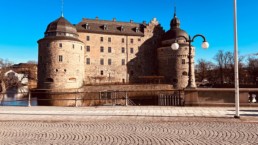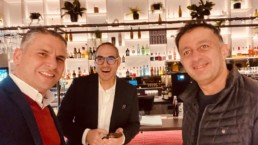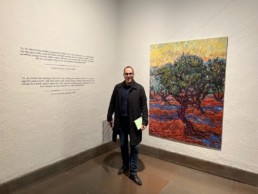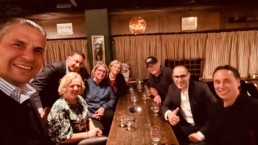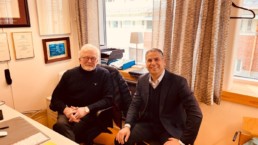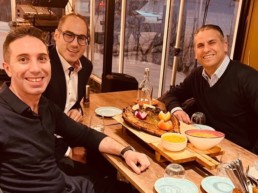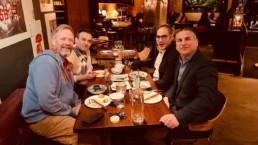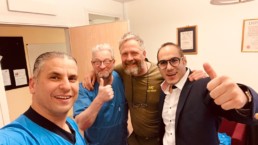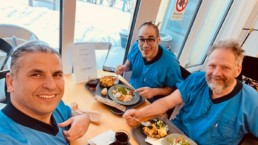This Fellowship took place in Sweden, in 3 leading areas of orthopaedic surgery: Orebro, Gothenburg & Stockholm. Our two fellows, Mr Mazin Ibrahim from London, UK and Dr Sufian S Ahmad from Hanover, Germany present their report…
It was a delightful experience to be part of the European Hip Society travelling fellowship to Sweden. We would like to express our heartfelt appreciation to the society for granting us this wonderful opportunity and extend our gratitude to EduCom Chairman, Prof Gosta Ullmark, who oversees the EHS Fellowship programme, and Samantha Stokes, who played a crucial role in helping to organize the fellowship. We also express our sincere gratitude to the hosts who generously devoted their time to accommodate us despite their demanding schedules. They not only welcomed us into their institutions but also provided us with valuable insights into their culture.
Orebro
The journey started in Orebro, where we were welcomed by our host Prof Per Wretenberg, who took us for a tour in Orebro Hospital and introduced us to the department. He hosted a dinner in his house with his wife Maria in the evening accompanied by some of his colleagues. We had a great dinner and a great exchange of knowledge, culture and funny stories.
The following two days in the arthroplasty department in Lindesbergs started early in the morning with a departmental meeting to discuss the cases for the day and we joined Prof Wretenberg in the operating room doing fantastic revision cases, including a revision of a diaphyseal fixation stem which had sunk to another larger stem and required an extended trochanteric osteotomy to remove the old stem. Other cases included primary total hip replacement and a fixation of periprosthetic fracture and others. We enjoyed the city and the hospital and the generosity of the Swedish culture.
Gothenberg
Next we boarded a train to Gothenberg. Our host, Assoc Prof Maziar Mohaddes, warmly welcomed us upon our arrival. In the evening, we dedicated time to devising a clear plan for the upcoming days.
The following day, we had the privilege of visiting Molndal Hospital, where we were greeted by Prof Henrick Malchau. Throughout the day, we had the opportunity to observe three intricate hip revisions in the operating room, all of which were skilfully performed by Prof Malchau. We benefited immensely from his wisdom and expertise. Particularly impressive was his execution of a trochanteric osteotomy to reshape the proximal femur in a complex revision case with pelvitrochanteric impingement, a technique he acquired directly from Sir Charnley himself.
Moreover, we engaged in fascinating discussions on topics such as cup failure, exploring diverse interests and geographical variations. Notably, in Germany, cranial segmental defects are commonly associated with previously implanted threaded cups, whereas in Sweden, cemented cups often lead to more manageable contained defects.
Following this, we had the opportunity to visit Capio Spine Centre Goteborg, a private hospital, where we joined Assoc Prof Mohaddes in observing surgical cases. We exchanged knowledge and experiences, engaging in discussions on surgical approaches and other aspects related to hip replacement surgery.
Later that day, we received a delightful invitation from the team to partake in an exciting brewery experience. This experience took place at the Gothenburg New Brewery and provided us with a very pleasant cultural encounter. The evening was a memorable one, filled with delectable food and enjoyable company. The brewery owners were exceptionally welcoming, providing us with entertaining insights into the beer-making process and its history.
On the weekend we enjoyed going to the city centre of Gothenburg to visit all the nice places like the art museum where we enjoyed Picasso and Van Gogh artwork. We walked through this pleasant city and enjoyed visiting the harbour and the opera house.
We again joined Prof Malchau in another revision hip which was a first stage revision hip for infection, and we used a dynamic spacer using the cemented stem and cemented cup.
Stockholm
We boarded the train to Stockholm, our final destination. The train provided us with a comfortable journey, complete with a Wi-Fi connection, which afforded us the opportunity to engage in discussions and knowledge-sharing.
We received a warm welcome from Prof Olof Skoldenberg at Danderyd Hospital. We joined the departmental daily XR meeting and had the pleasure of meeting the rest of the team, who graciously welcomed us. The meeting involved a multitude of cases for discussion, and we were divided to attend different operating theatres. The cases ranged from complex revisions to challenging primary procedures.
Our day ended late, coinciding with a snowstorm — an immersive first-hand experience of the Swedish winter weather! Remarkably, we also had the chance to reconnect with an old friend, Dr Mohanad Al-Bayati, an orthopedic surgeon from Huddinge Ortopedi and Sodermalmsortopedi clinics. Dr AL-Bayati kindly invited us to share a special fish meal.
We had the privilege of joining Prof Skoldenberg in the operating room for a revision case. During the procedure, we performed an extended trochanteric osteotomy to remove and replace a cemented stem by modular system, achieving excellent cone-in-cone fixation (Restoration, Stryker stem). Following this, we successfully addressed a case of periprosthetic fracture by utilizing a long NCB plate for fixation.
During the day, we enjoyed an exceptional lunch at the patient’s hotel restaurant and had the opportunity to meet other surgeons from various specialties.
In the evening, Prof Skoldenberg hosted a dinner at a delightful oriental restaurant in Stockholm city center. We were joined by Ihsan, another specialist in the arthroplasty department. To return to our hotel, we had the pleasure of experiencing the Swedish subway system.
On the final day, we participated in the arthroplasty meeting, engaging in discussions about complex cases and the hospital’s DVT prophylaxis protocol. We had the chance to exchange protocols from our respective organizations. Following the meeting, we joined the operating room for the last revision case, which involved extracting a Corail stem implanted seven years prior. Surprisingly, the procedure went smoother than expected, with the stem easily removed, giving us an early day off with a perfect result.
Saying goodbye to the hospital marked the end of our fellowship. It was an amazing and highly successful experience. Throughout our time, we participated in more than 10 complex revision hip cases, as well as other challenging primary cases. We exchanged valuable knowledge and experiences and established plans for further research collaboration and fellowship exchanges between our countries. We extend our heartfelt gratitude to the European Hip Society for providing us with this exceptional opportunity.


